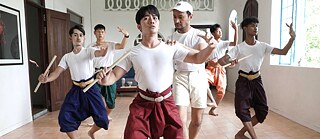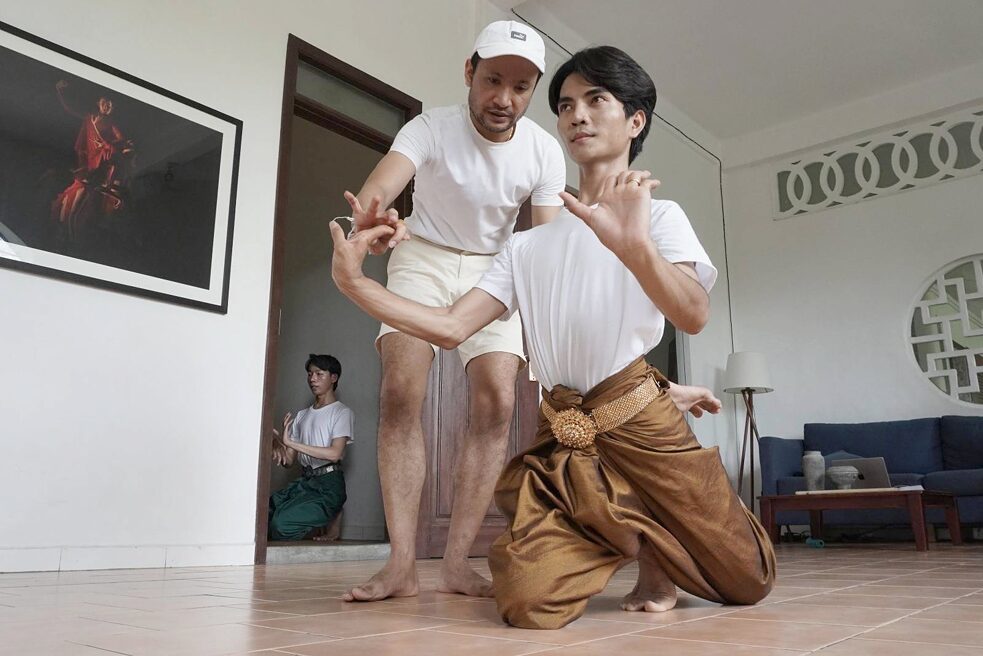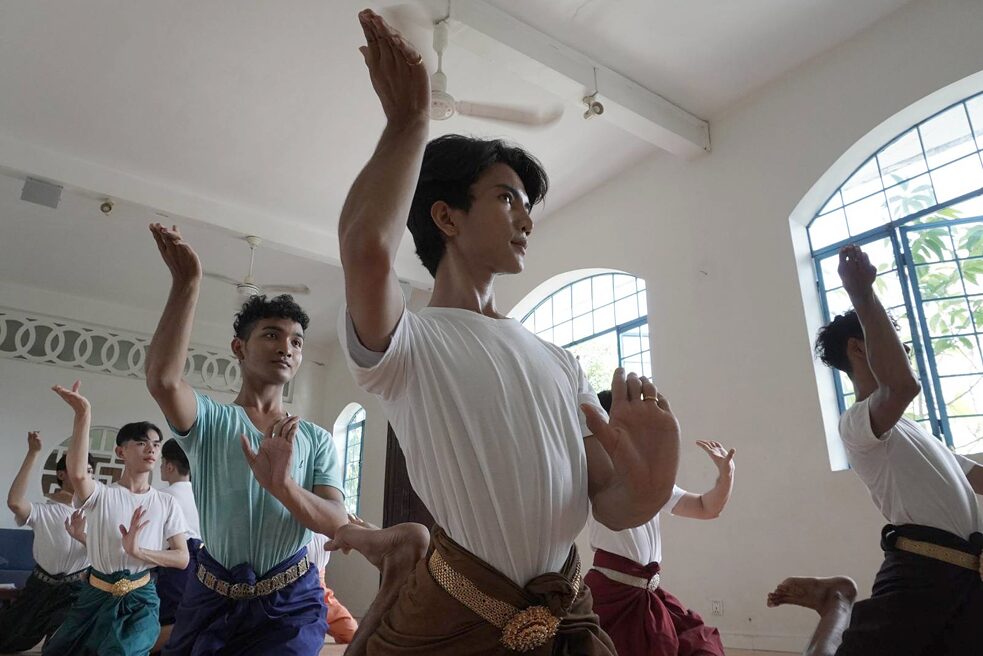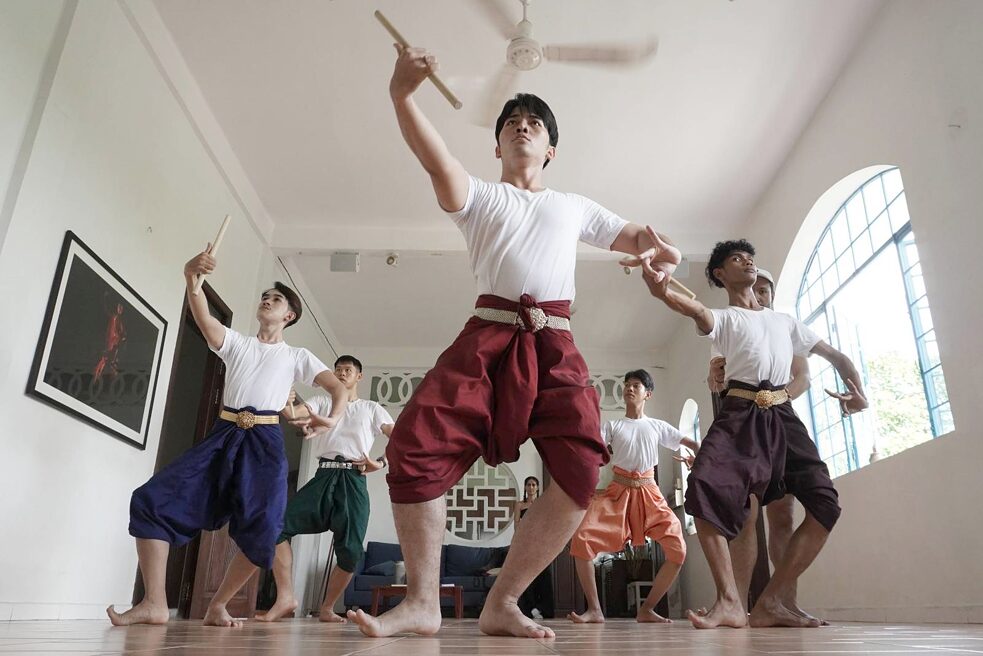Between Tradition and Queer Identities Cambodia’s “First Gay Dance Company”

Prumsodun Ok helps a dance student with a pose | Photo (Detail): © Kay Nara
Traditional Khmer dance and queer identities: this is the basis for Prumsodun Ok's dance company. He founded the first gay dance company in Cambodia.
In a room flooded with light, the dancers’ rhythmic voices resound in unison. In common time, they alternately stamp their left and right feet while artfully twisting their arms and hands. What looks like a dance studio with its terracotta tiles and colourfully decorated altar is Prumsodun Ok’s living room. The US-born Cambodian moved into this flat in Phnom Penh, Cambodia, seven years ago to found his dance company NATYARASA. His group has already performed in Germany and Japan, and a tour of the USA is planned. The members of the group all share a fondness for the folk dance of Cambodia called Khmer Classical Dance or Robam Preah Reach Trop, which requires elaborate costumes and is characterised by delicate, slow hand movements. The dance, which was originally reserved for the wealthy and the royal court, is considered the highest cultural asset of the people and is traditionally danced only by women. Uniquely, Prumsodun Ok’s dancers are all gay men.In a society where the majority are rather tolerant Buddhists, same-sex couples are not uncommon on the streets. In Cambodia, however, same-sex marriage is not legalised and social stigma is still prevalent. Especially in more rural areas, coming out publicly can lead to being ostracised from family and society. Despite this, Ok feels comfortable as a queer person in his home country. “It’s really intriguing; people are often shocked when I tell them that I feel safer here as a gay man than in America,” he says.
Since his first trip to Cambodia in 2008, the LGBTQ+ community has changed a great deal. It has become more visible, people express their identities more freely and publicly, and many initiatives advocate for equal rights. “I think categories like ‘queer’ can give us a voice and therefore power. Still, we have to be careful that the categories don’t become a cage in which we imprison ourselves,” says Ok, whose company’s main focus is dancing.
Combination of traditional Khmer culture and queer identities
Nevertheless, NATYARASA markets itself as the “First Gay Dance Company” and thus hits a nerve: Combining traditional Khmer culture and queer identities seems like a contradiction to many people. But Ok, who studied classical dance and its history intensively, sees clear similarities. “We don’t have very many Khmer documents, but the few we do have go back to the 13th century. In the reimke, one of the most important classical dramas, there is a section where a kdoy, someone who is neither female nor male, is charged with looking after the heroine. This is a position of power and privilege.” Ok sees the fact that the old texts function without binary gender division as proof that people who do not identify with classical gender roles have always been part of society.In the heart of Phnom Penh, the filmmaker is already training the second generation of dancers, divided into professional artists and young talents. The latter do not always bring the appropriate previous knowledge with them. “I don’t find the dancers; I make them dancers here. My job as a teacher is to awaken the art in them. To see the moment in their eyes when they finally understand why they do what they do. Then they embody beauty.”
Khuoen Chay stands out in particular. After the music fades away, he waits until his teacher gives the signal before his shoulders slump in exhaustion and his body relaxes. Between dance sessions, he wipes the sweat from his brow and gives everyone water. The tall 25-year-old joined the company in 2019. Before that, he lived in a rural outskirt of the capital and only noticed the dance group as an outsider. “I knew NATYARASA existed, but I didn’t dare to become part of it. My family didn’t support me at that time and I was worried about being alone. Now I know that this work here is my dream and I can do it!” Khuoen is one of the company’s most promising dancers and plans to move to Thailand in the summer to become successful internationally as well. He is positive about his time in the company. “When I came here, I thought being a dancer was easy. But here I learned that nothing is harder than being an artist. I had to work hard because normally classical dancers train from childhood. Still, I wouldn’t trade the company for anything in the world,” the young man confesses.
What Ok has established, however, is not only met with approval. The combination of traditional and gay culture is irksome to the older generation in particular. Initiatives demanding the closure of the company were very active, especially at the beginning. But in the meantime, Ok’s dance company is even an inspiration to demographics who do not identify with the queer group. “The older ones recognise the value of my art. Even if they don’t understand or approve of certain decisions, they appreciate me as a teacher. Some don’t like the fact that we are a gay dance company, but they support our efforts to carry on classical Khmer culture,” Ok says.


